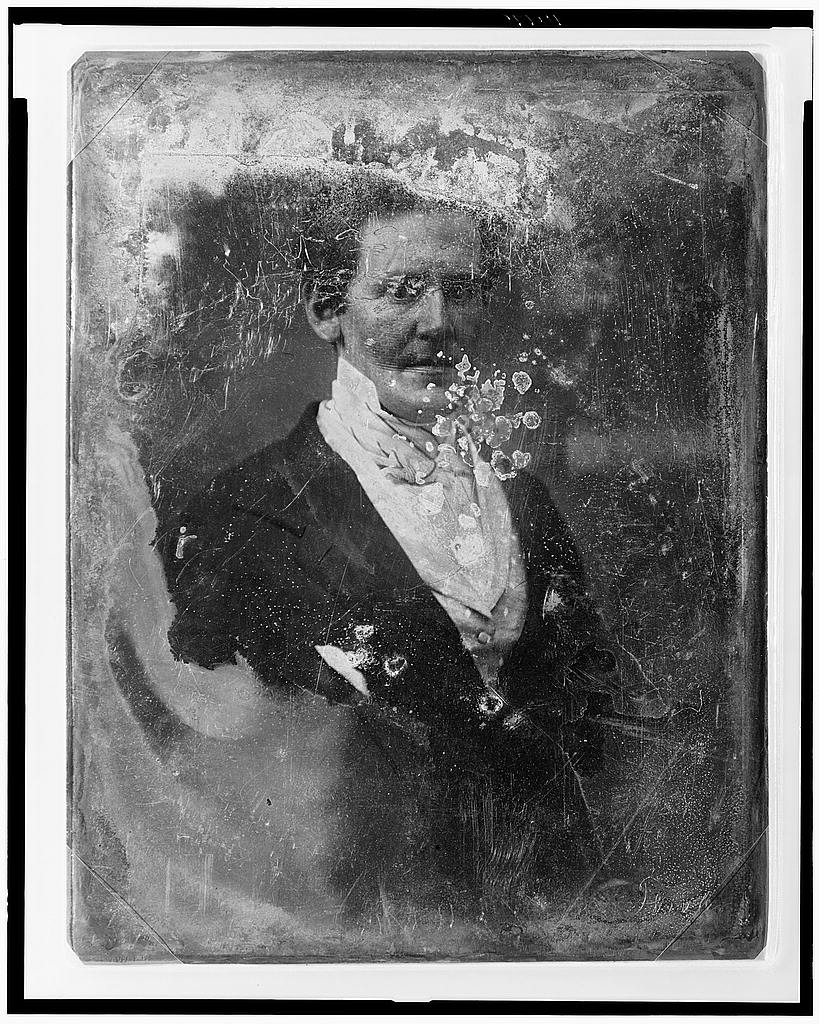Can a daguerreotype image really be wiped right off the plate?
In a follow-up to my previous podcast about Southworth & Hawes (episode 23), we research whether the daguerreotype image can really wipe right off the plate.
There’s a common perception, supported by much early documentation, that antique daguerreotypes are easily wiped off the silver plate. But modern science seems to contradict that. Listen to find out what I learned.
Scroll down for full written transcript.
The book referenced in this episode

The Daguerreotype: Nineteenth Century Technology and Modern Science
by M. Susan Barger and William B. White (available new and used on Amazon)
Cover art: Daguerreotype portrait of Louis Daguerre, inventor of the process, photographed in 1844 by Jean-Baptiste Sabatier-Blot.
Thanks for reading.
Be sure to visit me on Facebook, Instagram or Pinterest, or on my website at keithdotson.com.
~ Keith

Full audio transcript
Episode 24 ‘Daguerreotypes: How Fragile Are They?’
In this episode of the fine art photography podcast: a quick followup to my discussion of daguerreotypes from last time — just how fragile were they?
Hey everybody, Keith Dotson here, and in this short episode, I want to follow up to a discussion of daguerreotypes in my previous episode no 23. about Southworth and Hawes. In that episode, I indicated that the surface of a daguerreotype print is so fragile that it can easily be wiped off the plate.
I did a pretty deep dive into the process of making daguerreotypes. As part of that, I explained that the light sensitive plates were made of sheets of copper, electroplated with silver, then the silver surface polished through an elaborate step-by-step process to a mirror-like finish. The silver surface was then fumed in safelight conditions with various chemicals, creating a delicate invisible emulsion across the surface of the silver. The sensitized silver sheet was then inserted into a plate holder and taken to the camera, where it was exposed and then back to the darkroom for processing with yet another fume of heated mercury.
The daguerreotypes were then protected under glass in elaborate frames, because as you can see, they are just a piece of silver-plated metal with a film of fumed chemicals across its surface. By what I read in the documents from the 1840s and 1850s, they were easily wiped away by the slightest brush of a silk handkerchief. To quote one source — they were as “delicate as the dust on a butterfly’s wing.”
Now according to Southworth, who I discussed at length in episode 23, one solution for this fragile condition was to dip the finished image in a bath of gold chloride, which toned and hardened the print — a process he called gilding.
And regarding the permanence of daguerreotypes, I recited a direct quote from Southworth to his clientele in which he said that daguerreotypes are permanent and will not fade, nor evaporate, and that they were suitably sturdy when treated with the gold chloride. But he advised never to try to clean the surface because it’s easily wiped away.
But since recording that episode, I’ve been doing further reading on the process, and according to the book aptly named, The Daguerreotype, by M. Susan Barger and William B. White, daguerreotypes are not really so fragile at all.
On page 201, the authors quote a passage from another book, saying that a daguerreotype is permanent and the picture cannot be rubbed off the plate.
Barger and White are bonafide scientists — both professors. They go into exhaustive detail — along with the microscopic photos of print surfaces to prove it — that daguerreotypes do suffer all kinds of long-term problems, but apparently they do not fade and after they have been aged on the silver — they are quite resilient. This is especially true for the ones gilded with the gold chloride.
Apparently in addition to the gold chloride toner, early photographers also tried various other varnishes and coatings, which seem to have done more harm than good. In many cases the varnishes aged poorly and cloaked or darkened the image beyond recognition. Those old varnishes are hard to remove safely without damaging the image.
But there’s also the fact that daguerreotypes were imaged onto silver, which of course, tends to tarnish over time. And, while a daguerreotype image may be permanent and resilient, the silver itself is prone to abrasion or scratching if rubbed too vigorously with the wrong material.
Barger and White go into detail about the many ways that photographers and conservators have tried to clean or restore daguerreotypes over the decades. A lot of chemical and electrolytic methods have been tried. Most have damaged the integrity of the image immediately or had a deteriorating effect over time. Even effective cleaning methods struggle to deal with tarnish occurring under the image area.
I’ll include a link to the Barger and White book called The Daguerreotype in the description. There’s a lot of science in there that’s way over my head, but it also includes a nice history of early photography with many reproductions of early daguerreotypes.
Well that’s all I’ve got for this episode — if you haven’t listened to episode 23 about Southworth and Hawes — please go check it out. They were super impressive — among America’s first great photographers.
I’ve got lots of podcast episodes in the works, so be sure to subscribe and I’ll talk to you again real soon.
